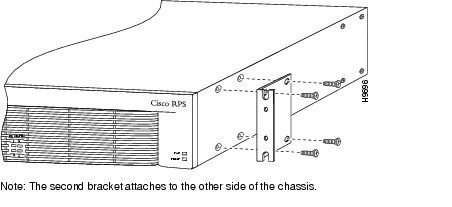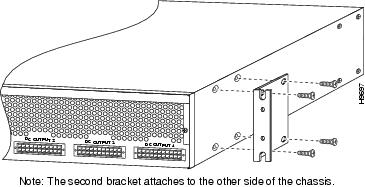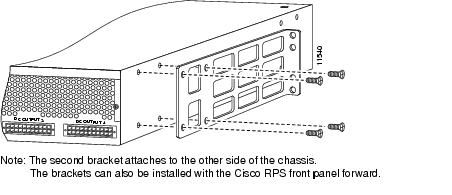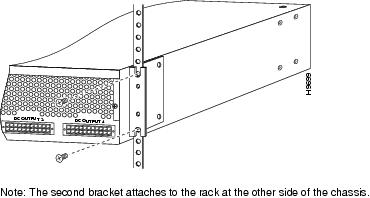

Table Of Contents
Setting the Cisco RPS on a Desktop
Planning Your Rack-Mount Installation
Identifying Rack-Mount Brackets
Mounting the Chassis in a Rack
Installing the Cisco RPS
You can set the Cisco RPS chassis on a desktop or install it in a rack.
Warning
Only trained and qualified personnel should be allowed to install or replace this equipment. To see translations of the warnings that appear in this publication, refer to the Regulatory Compliance and Safety Information document that accompanied this device.
Warning
Do not work on the system or connect or disconnect cables during periods of lightning activity. To see translations of the warnings that appear in this publication, refer to the Regulatory Compliance and Safety Information document that accompanied this device.
Warning
Before opening the chassis, disconnect the telephone-network cables to avoid contact with telephone-network voltages. To see translations of the warnings that appear in this publication, refer to the Regulatory Compliance and Safety Information document that accompanied this device.
Warning
This equipment is intended to be grounded. Ensure that the host is connected to earth ground during normal use. To see translations of the warnings that appear in this publication, refer to the Regulatory Compliance and Safety Information document that accompanied this device.
Warning
Never defeat the ground conductor or operate the equipment in the absence of a suitably installed ground conductor. Contact the appropriate electrical inspection authority or an electrician if you are uncertain that suitable grounding is available. To see translations of the warnings that appear in this publication, refer to the Regulatory Compliance and Safety Information document that accompanied this device.
Warning
When installing the unit, the ground connection must always be made first and disconnected last. To see translations of the warnings that appear in this publication, refer to the Regulatory Compliance and Safety Information document that accompanied this device.
•
Do not work alone if potentially hazardous conditions exist.
•
Never assume that power is disconnected from a circuit. Always check.
The Cisco RPS location is extremely important for proper operation. Equipment placed too close together, inadequate ventilation, and inaccessible panels can cause malfunctions and shutdowns and can make maintenance difficult. The following information will help you to plan the location of the chassis.
•
Plan for access to both the front and rear panels of the Cisco RPS.
•
Make sure that the room where the Cisco RPS operates has adequate ventilation. Remember that electrical equipment generates heat. Ambient air temperature might not cool equipment to acceptable operating temperatures without adequate ventilation. (See Table A-1.)
Use the procedure that best meets your needs:
•
"Setting the Cisco RPS on a Desktop" section
•
"Rack-Mounting the Cisco RPS" section
Setting the Cisco RPS on a Desktop
Warning
Do not stack the chassis on any other equipment. If the chassis falls, it can cause severe bodily injury and equipment damage. To see translations of the warnings that appear in this publication, refer to the Regulatory Compliance and Safety Information document that accompanied this device.
Warning
This unit is intended for installation in restricted access areas. A restricted access area is where access can only be gained by service personnel through the use of a special tool, lock and key, or other means of security and is controlled by the authority responsible for the location. To see translations of the warnings that appear in this publication, refer to the Regulatory Compliance and Safety Information document that accompanied this device.
To install your chassis on a desktop, perform the following steps:
Step 1
Unpack the Cisco RPS.
Step 2
Attach the rubber feet from the accessory kit in the round recesses on the chassis bottom.
Step 3
Set the Cisco RPS chassis on an appropriate desktop.
Step 4
Plug in the Cisco RPS, and turn power on.
Note
If you have questions or need assistance, see the "Obtaining Documentation" section on page xviii.
Rack-Mounting the Cisco RPS
This sections explains how to rack-mount the Cisco RPS in 19-, 23-, 24-inch, or telco equipment racks. Read the following information before rack-mounting your chassis.
Planning Your Rack-Mount Installation
Warning
To prevent bodily injury when mounting or servicing this unit in a rack, you must take special precautions to ensure that the system remains stable. The following guidelines are provided to ensure your safety. To see translations of the warnings that appear in this publication, refer to the Regulatory Compliance and Safety Information document that accompanied this device.
•
This unit should be mounted at the bottom of the rack if it is the only unit in the rack.
•
When mounting this unit in a partially filled rack, load the rack from the bottom to the top with the heaviest component at the bottom of the rack.
•
If the rack is provided with stabilizing devices, install the stabilizers before mounting or servicing the unit in the rack.
The following information will help you plan your equipment rack installation:
•
Enclosed racks must have adequate ventilation. Make sure that the rack is not congested, because each unit generates heat. Heat generated by equipment near the bottom of the rack can be drawn upward into the intake ports of the equipment above. An enclosed rack should have louvered sides and a fan to provide cooling air.
•
When mounting a chassis in an open rack, make sure that the rack frame does not block the intake or exhaust ports. If the chassis is installed on slides, check the position of the chassis when it is seated in the rack.
•
Baffles can isolate exhaust air from intake air, which also helps to draw cooling air through the chassis. The best placement of the baffles depends on the airflow patterns in the rack, which can be found by experimenting with different configurations.
•
When equipment installed in a rack (particularly in an enclosed rack) fails, try operating the equipment by itself, if possible. Power off other equipment in the rack and in adjacent racks to allow the unit under test a maximum of cooling air and clean power.
•
Install the Cisco RPS and the external device to which it will connect in adjacent shelves in a rack.
Tools and Equipment Required
You need the following tools and equipment to rack-mount the Cisco RPS:
•
Number 2 Phillips screwdriver (not included)
•
Screws for attaching the Cisco RPS to the rack (not included)
•
Rack-mount brackets (see Figure 2-1 and Figure 2-2):
–
One set of 19-inch brackets (ACS-3640RM-19=) ships with the Cisco RPS.
–
Order 23- or 24-inch brackets (ACS-3640RM-24=), as needed.
–
Order telco brackets (AS52/3RM-TELCO-19=), as needed.
Identifying Rack-Mount Brackets
Figure 2-1 shows the 19-, 23-, and 24-inch brackets; Figure 2-2 shows the telco bracket.
Figure 2-1 19-, 23-, and 24-Inch Rack-Mount Brackets
Figure 2-2 Telco Bracket
Attaching Brackets
To install the Cisco RPS in a rack, attach the brackets in one of the following ways:
•
With the Cisco RPS front panel forward (see Figure 2-3).
•
With the Cisco RPS rear panel forward (see Figure 2-4).
•
In a center-mount telco rack (see Figure 2-5).
Note
Although Figure 2-3 and Figure 2-4 show 19-inch brackets, the procedure is the same for 23-inch, 24-inch, and telco brackets.
Figure 2-3 Bracket Installation—Front Panel Forward
Figure 2-4 Bracket Installation—Rear Panel Forward
Figure 2-5 Telco Bracket Installation—Rear Panel Forward
Mounting the Chassis in a Rack
After the brackets are secured to the chassis, use your own screws to attach the chassis to the rack, as shown in Figure 2-6.
Figure 2-6 Attaching the Chassis to a Rack—Rear Panel Forward

 Feedback
Feedback






